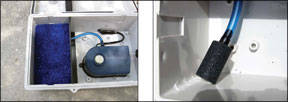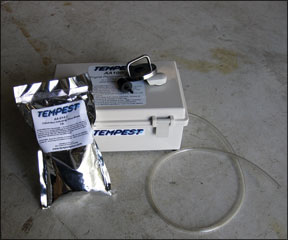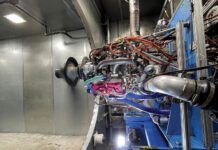Think of Florida on a warm afternoon in July and youve got a good grasp of what your engine crankcase is like after you shut down after a flight. Throw in a little acid rain to season the heat and humidity to complete the picture. In short, the inside of an engine can be the perfect Petri dish for corrosion. Engine dehydrators or preservers are designed to address this by either pumping dry air into the engine, or sucking the humid miasma out of the crankcase and replacing it with moisture-free air. The idea has enough credence for three companies to have introduced dehydrator products. The latest comes from Tempest/Aero group, which adds a dehydrator to its well-regarded line of dry vacuum pumps and oil filters. The AA1000 Engine Preservation Systems retails for $235.
What It Is
Like the other engine preservers, the Tempest dehydrator pumps dry air into the engine after first passing it through a silica gel desiccant. The device consists of a small plastic enclosure about the size of small fishing tackle box-it may actually be a tackle box, by the looks of it-divided into two compartments.
One compartment serves as a cell to contain the desiccant, which consists of about a pound of tiny blue beads. You just pour them in the box, making sure that the filtered pickup tube is near the bottom of the desiccant. The other two thirds of the box houses a small, continuous duty low-volume air pump powered by line voltage. A clear plastic tube exits the pump to be inserted into the crankcase oil filler.
To make that easy, Tempest provides a lab-type rubber stopper for Lycomings with a fitting for the hose and a magnetic cap for Continentals. The cap has a hole for the plastic tube, so its easy to install it. The construction of this gadget is up to the task, but it has two flaws, in our view. Both the plastic tube and the line cord are too short. For our test in a Bonanza, we had to place the box on top of the engine, then snake the tube down into the filler. The power cord was so short that we needed an extension cord and this produces a snag hazard.
Because Murphy is a current resident in every hangar, what will eventually happen is that someone will trip on the extension cord, knock the box off the airplane and spill billions upon billions of little blue desiccant balls all over the floor. You will be sweeping them up for 100 years. The thing should sit on the floor, as the other two products of this type do, so it needs a longer hose.
Performance
To test the AA1000, we first gathered some control data by installing digital data loggers at the oil filler neck and in the hangar, as explained in the chart at right.

We wanted to see what the crankcase humidity was doing relative to ambient without the dehydrator installed. No surprise that the crankcase humidity tracks the hangar humidity. If you have a dry hangar, you probably have a dry engine.
At times during the day, the crankcase is a little more humid than the hangar; at times its less. In Florida, where the test was done, humidity levels follow a cycle throughout the day, dropping to as little as 45 percent during the morning and afternoon before peaking at 70 percent or higher during the summer mornings and evenings.
Before starting the test, we flew the airplane for 30 minutes to warm the oil and we let it cool for an hour to keep from melting the data logger. As shown in the chart, the crankcase humidity started out at 100 percent (and 131 degrees) and once the engine preserver was started, it immediately drove the humidity to the mid-20 percent range. As the test progressed, the crankcase humidity slowly rose, but it remained below the ambient humidity. Were not sure why this happened. It didnt appear as though the desiccant was saturated.
In our previous tests of these devices (see September 2006 issue), we concluded that best drying efficiency is achieved through a minimal air flow. Thats because the crankcase volume is quite small-about the size of medium shipping box-and cycling more air through it than necessary simply saturates the desiccant more rapidly. The material can be regenerated up to 20 times, says Tempest, by baking it in a household oven. But the stuff is a nuisance to handle and is just begging to bounce and spill everywhere but into the baking pan.
The AA1000 runs continuously, but the flow is restricted by the air intake, which has a porous filter rather than an open tube. We didnt measure the flow, but with the pump running, you can just detect it by holding the hose near your cheek or lip.
Conclusion
Like the other two dehydrator products-one from Tanis and the Engine Saver from Aircraft Components-this device seems to perform as claimed. At $235, its the least expensive and the smallest, but also the third place finisher in performance. The more expensive products ($285 for the Engine Saver, $425 for the Tanis) are marginally more effective at drying, according to our tests. Further, the Engine Saver has a cycling switch which helps to preserve the desiccant. Do these things really work? Well, they really make the crankcase dryer. Our findings show that. But we cant vouch for the overall efficacy in controlling corrosion. It stands to reason that corrosion will be reduced if the air in the crankcase is dryer rather than wetter. We simply have no data to correlate the two. We continue to believe that the best defense against corrosion is frequent engine operation and an oil with an effective anti-corrosion package. Our top choice remains Phillips XC additized with CamGuard.





